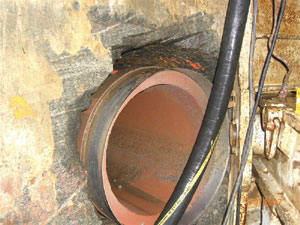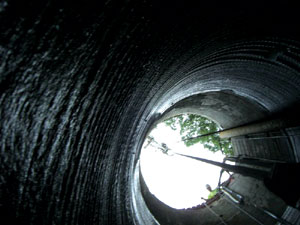On-Grade in Granite in Atlanta
 It’s not too often that the methods of horizontal directional drilling and pilot-tube microtunneling cross paths in dramatic fashion in one project. But that’s what happened in the City of Atlanta last summer when the best of both trenchless methods were utilized to install a sewer pipe.
It’s not too often that the methods of horizontal directional drilling and pilot-tube microtunneling cross paths in dramatic fashion in one project. But that’s what happened in the City of Atlanta last summer when the best of both trenchless methods were utilized to install a sewer pipe.
What made the project so phenomenal? The ground conditions were of varying types of granite — which ranged from 35,000 to 50,000 psi at any given spot — and the drilling crew had to stay on line and grade while drilling 40 ft below grade.
That’s what McCowien Drilling of Pierpont, Ohio, was facing when it was contacted by general contractor Reynolds Inc. in February 2007, to help out with the Greensferry Sewer Separation project — a $100 million project to separate sewer and storm water pipes all over the city. McCowien Drilling was asked to drill four bores totaling 1,000 ft to install 18-in. clay pipe.
The 18-in. Can-Clay Denlok clay pipe was to be installed from two launch shafts into four reception pits, that varied in depth from 20 to 40 ft. The bores ranged in length from 180 to 295 ft, with the longest bore containing mixed soil conditions of varying degrees of the granite. The project was located across from Morehouse College and was pivotal to the completion of the overall project.
“Nobody thought it could be done,” said Rick McCowien, owner of McCowien Drilling, who has been in directional drilling for 10 years. “We were basically told by the project engineers that ‘Here’s an 8-ft shaft and we need 18-in. pipe installed from here to here.”
Never dissuaded from tackling a challenge, McCowien reviewed the project particulars and knew right away that conventional directional drilling wouldn’t be the answer — the granite and grade restrictions would prevent that. He consulted with colleague Craig Shaw and son Derrick McCowien, and together they decided that some aspects of directional drilling could be used in combination with pilot-tube microtunneling to get the project finished.
So instead of using a conventional directional drill rig to drill the pilot hole, McCowien’s crew used an Akkerman 308 guided boring machine (GBM). HDD tooling, such as a Halco Storm 500 air hammer, was used with the GBM to drill the hole and later enlarge it to the required diameter. The GBM was also used to push the 18-in. clay pipe into the hole.
“We were working 40 ft below grade in solid granite. In order to use a conventional HDD drill, you would have to sit on top of the ground and way back from where the start of your borehole would be, go down to the depth and be on grade at that point and then continue on grade,” McCowien said. “With a conventional HDD system, you cannot keep the tolerance as close as we did with the GBM.
“Most of your guided boring machines are used for pilot-tube boring… They push, not drill and are mostly used to stay on grade,” McCowien said. “For the pilot hole, it was drilled with an air hammer to rotate.”
He also said conventional HDD tooling like mud motors wouldn’t have been a match for the granite or the location of the job. “You could have possibly drilled it with mud motors but those are typically 20 ft long and we were drilling from an 8-ft shaft,” McCowien said.
Facing a Sept. 26 deadline, McCowien Drilling arrived in Atlanta in April, spending the first two months of the project fabricating secondary tooling they would need and tracking down locating materials. Materials were found with help from Reynolds Inc. Fabrication for the shaft began with wall plates, ladders and hose brackets and was complete with the construction of a snorkel, designed to deflect and carry the cuttings out of the shaft and into a vac truck.
The Bores
 An Akkerman 308 GBM system is a jacking frame designed to be lowered into a shaft. The system’s hydraulic power pack sits at ground level, providing power to the frame. The guidance system consists of a theodolite, computer screen and illuminated LED target. This system was used to core drill a 14-in. hole, 3 ft deep. A Halco Storm 500 air hammer with a 5.25-in. bit was used to drill the pilot hole through 34,000-psi granite. The air hammer drilled 295 ft at +0.4 percent, taking six days to finish the pilot hole. Water was encountered, as well as 30 ft of sand, creating an obstacle. The pilot bore, nonetheless, was completed on line and grade.
An Akkerman 308 GBM system is a jacking frame designed to be lowered into a shaft. The system’s hydraulic power pack sits at ground level, providing power to the frame. The guidance system consists of a theodolite, computer screen and illuminated LED target. This system was used to core drill a 14-in. hole, 3 ft deep. A Halco Storm 500 air hammer with a 5.25-in. bit was used to drill the pilot hole through 34,000-psi granite. The air hammer drilled 295 ft at +0.4 percent, taking six days to finish the pilot hole. Water was encountered, as well as 30 ft of sand, creating an obstacle. The pilot bore, nonetheless, was completed on line and grade.
Due to the mixed ground conditions at the tail end of the bore, a 30-in. casing system was designed and built on location. The casing system was successfully installed and solved the sand problem encountered. The pilot bore was upsized from 5.25 to 12 in., taking two days to finish. Three 1,150-cfm, 500-psi sullair compressors were set up for a combined cfm of 3,450. The air compressors were positioned and the fluid system was in place. The bore was enlarged from 12 to 26 in., taking three weeks to complete.
The third bore was in metamorphic granite ground conditions, ranging from 35,000 to 50,000 psi. Setup time was two days, and the drilling of the pilot hole lasted four days and was at -1.0 percent grade. The pilot bore was 180 ft in length and finished on line and grade.
As relatively smooth as the first three bores were, challenges arose in drilling the fourth and final bore, as the drilling tools, working in the solid granite, suffered fatigue and eventually failed — which was not totally unexpected by McCowien. The metal in the drilling tools fatigued about 170 ft into the 210-ft bore, causing the only LED target housing available to crack and bringing the job to halt. To correct the problem, the target housing was redesigned, and a new tool was built, taking seven days. Once work resumed, it took one day to complete the pilot bore, on line and grade at +0.5 percent. The pilot hole was enlarged to 26 in. in 21 hours.
An 80,000-lb Tulsa Rig Iron directional drill was used to backream all but the first bore, enlarging the holes to 26 in. in two reaming passes. When pressed as to how this was accomplished using the drill rig, McCowien was coy about his success, saying he didn’t want to divulge that project secret.
All four bores were completed on line and grade, 12 days before the Sept. 26 deadline to the satisfaction of the City of Atlanta. For the last bore, McCowien’s crew worked 24 hours a day to complete it. During the duration of the four bores, security and traffic flow was maintained by the Atlanta police department.
McCowien Drilling, with cooperative efforts from Rock Drill Solutions, achieved not only a successful outcome, but established itself as the first company to use a guided boring machine in
high psi granite, McCowien said. In McCowien’s opinion, only 3 to 5 percent of companies undertaking this venture would be successful in their attempts.
He said one of the most difficult aspects of the job was dealing with the granite and its effect on the equipment. “I knew from the beginning that eventually the granite was going to fatigue the tooling and we were going to have a failure at some point,” McCowien said. “And on the last bore, we did have a tooling failure. We had a tooling failure due to the fact that the rock was so hard that it fatigued the metal. We had to retrieve some of the tooling out of the hole and then have new tooling built to complete that part of the hole.
“That was probably the hardest part of the project,” he added. “The tools we had were the only ones available because we built them.”
Without the determined and innovative efforts and dedication of McCowien Drilling, the City of Atlanta would have been faced with fines, possibly jeopardizing the entire project.
Others that played a role in the success of the project were: Reynolds Inc., Ruby Collins Inc., Can-Clay Corp., Georgia Pump, Georgia Underground, YanceyCat, Bowers Fabrication, Southern Hydrovac, the Atlanta police department and the Fulton County sheriff’s department.
The Greensferry Sewer Separation Project was a tremendous success for McCowien Drilling, the City of Atlanta and everyone involved with the project.
Sharon M. Bueno is managing editor of Trenchless Technology. Photos courtesy of Can-Clay Corp.
